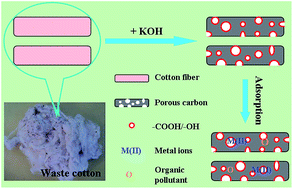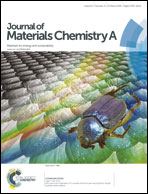Cotton derived carbonaceous aerogels for the efficient removal of organic pollutants and heavy metal ions†
Abstract
Well-structured cotton derived porous carbon (CDPC) and cotton derived porous carbon oxide (CDPCO) were fabricated via a facile and economic alkaline etching method and were used as adsorbents for waste water cleanup. As a carbon source, natural cotton waste was dehydrated with sodium hydroxide at low temperatures and further etched at high temperatures in a thermal treatment process. The synthesized CDPCO exhibited an excellent adsorption performance of organic pollutants and heavy metal ions such as methylene blue, 1-naphthylamine, Cd(II) and Co(II) in aqueous solutions. The adsorption mechanism was investigated via FT-IR analysis and controlled experiments, and it was concluded that the organic pollutant removal was affected by the molecular size of the organic pollutants and the ionic interactions between the pollutants and adsorbents. The adsorption of heavy metal ions was dependent on the interactions between the heavy metal ions and functional groups on the adsorbents’ surfaces. The adsorption process fitted the Langmuir model better than the Freundlich model. Our results suggested that CDPC could be a favorable adsorbent for the removal of organic pollutants and heavy metal ions from aqueous solutions.


 Please wait while we load your content...
Please wait while we load your content...